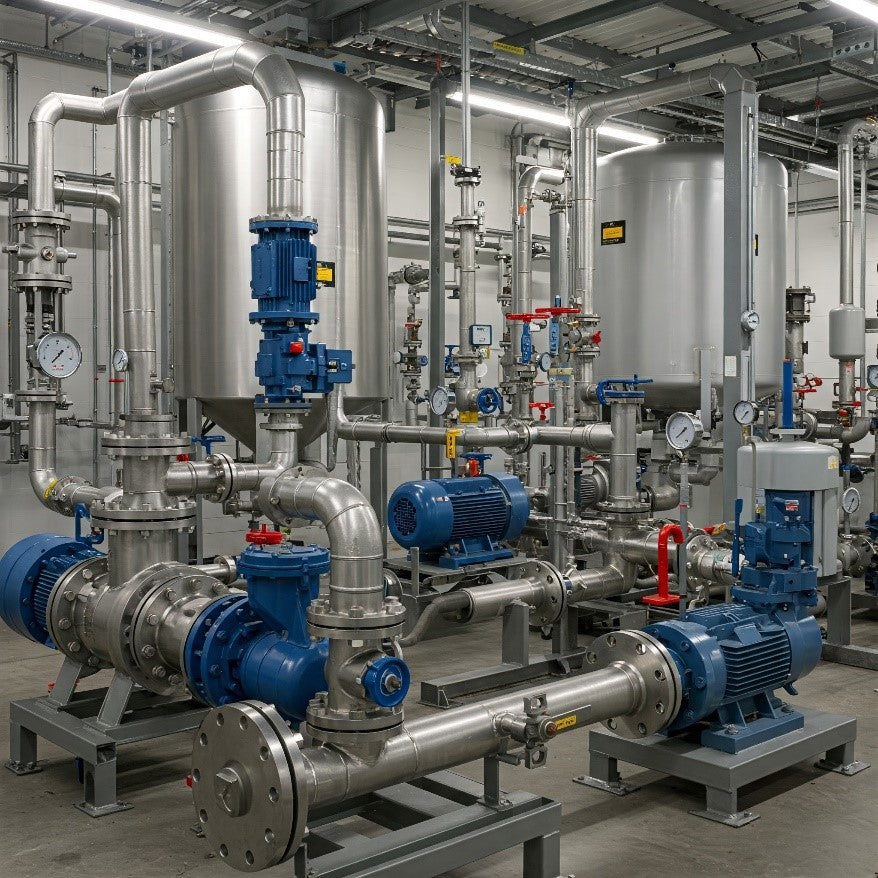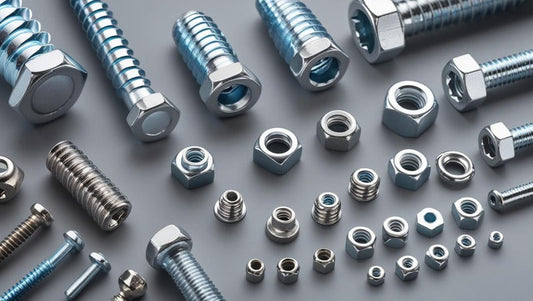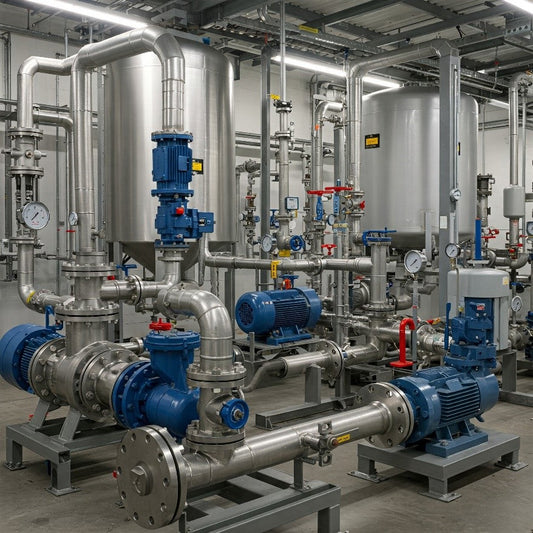Fluid Management

Grindmel´s Engineering Team
We are a Honduran company founded by mechanical and electrical engineers.
CONTENT

At the heart of almost every industrial process is one common factor: the movement and control of fluids. Whether in a food plant, a construction site, or an energy refinery, proper management of liquids and gases is essential to maintaining efficiency, safety, and productivity. However, it rarely receives the attention it deserves. In this article, we'll explore what fluid management is, its main applications in different industries, the most common types of fluids, and why efficient management can make the difference between a successful system and one plagued by failures and losses.
What is Fluid Management and Why is it Crucial in Industry?
Fluid management is a key discipline in engineering and industrial operations. It encompasses the design, control, transportation, and processing of liquids and gases within closed or open systems. From pumping water in a food plant to transporting chemicals in pharmaceutical facilities, fluid management is essential to ensuring safe, efficient, and sustainable processes.
Where is fluid management applied?
This field has applications in multiple industrial sectors. Some of the most notable are:
- Food industry: transportation of water, milk, juices, oils, and other liquid products; CIP (Clean-In-Place) cleaning processes; temperature control with thermal fluids.
- Construction: handling liquid concrete, plumbing, drainage, and HVAC (heating, ventilation, and air conditioning) systems.
- Energy: transportation of natural gas, oil, steam and water for electricity generation or refining processes.
- Pharmaceuticals: Ultrapure systems for liquids, gases, and solutions; compliance with sanitary and sterility standards.
Types of fluids in industry
Industrial fluids are mainly divided into three categories:
- Liquids: water, oils, fuels, liquid foodstuffs, chemicals. They require pressure, temperature, viscosity, and material compatibility control.
-
Gases: compressed air, steam, industrial gases (nitrogen, oxygen, CO₂, etc.).
They tend to be more compressible, require different calculations and greater pressure control.
- Mixtures: suspensions, emulsions, or slurries. These are usually more difficult to transport and require specialized equipment such as peristaltic pumps or agitators.
Key Components and Equipment in Fluid Handling
- For a fluid handling system to operate safely and efficiently, selecting the right components is essential. Pumps, valves, pipes, and measuring equipment not only transport the fluid but also ensure control, process quality, and compliance with technical regulations. Below, we explore the essential equipment and their main features.
1. Industrial Pumps: Types and Uses
Pumps are the heart of the system. Their function is to move fluids from one point to another, overcoming resistance caused by friction, height, or pressure. There are several types depending on the application and type of fluid:
- Centrifugal pumps: Used for clean, low-viscosity liquids. They are common in water, chemical, and food processes. They are efficient and low-maintenance.
Illustration 2 Source: Irrigation.es
- Positive displacement pumps: Like piston, diaphragm, or lobe pumps, these are ideal for viscous liquids, those containing particles, or those requiring a constant flow. They are widely used for oils, syrups, and pharmaceutical products.
Illustration 3 Source: Multidronet Illustration 4 Source: Ashm
- Peristaltic pumps: They handle corrosive, viscous, or solid-containing fluids without contaminating the product, as the fluid never comes into contact with mechanical components. Ideal for biotechnology and chemistry.
Illustration 5 Source: albinpump.com
2. Compressors: Types and Uses
A compressor is a mechanical device that increases the pressure of a gas by reducing its volume. It's similar to a pump, but instead of liquids, it works primarily with gases such as air, nitrogen, carbon dioxide, or natural gas.
Compressors are vital in fluid handling because:
- They generate pneumatic energy.
- They allow the transport of compressed gases in pipes.
- They are essential for cooling, filtration, cleaning and automation processes.
There are several types of compressors, classified mainly according to their operating principle:
1. Positive Displacement Compressors
These compressors work by trapping a specific volume of gas and reducing its space to increase pressure.
- Piston (Reciprocating) Compressor:
- It uses a piston that moves in a cylinder.
- Ideal for high pressures (up to 3000 psi).
- Common in workshops, industrial plants and refrigeration systems.
- Rotary Screw Compressor:
- It uses two spiral rotors.
- Continuous and quieter operation.
- Recommended for medium and large scale industrial applications.
Illustration 6 Source: Areatechnology
- Vane Compressor:
- It uses moving vanes inside an eccentric rotor.
- Compact and suitable for light and medium duty applications.
Illustration 7 Source: Geogebra
2. Dynamic Compressors
These compressors accelerate the gas to high speed and then decelerate it to increase its pressure.
- Centrifugal Compressor:
- Common in air conditioning systems, gas turbines and natural gas compressors.
- They require high speeds and are more efficient in large, continuous flows.
Illustration 8 Source: Ayrful
- Axial Compressor:
- Used in aviation turbines and power processes.
- High efficiency in large flow volumes.
Illustration 9 Source: Academia-Lab
3. Valves: Types and Uses
Valves allow you to control, stop, or redirect the flow of fluid in a system. Their choice depends on the type of fluid, operating pressure, and desired level of automation.
- Gate valves:
It opens or closes the flow of fluid using a vertically sliding gate. It is primarily used to completely open or close the flow, not to regulate it. Commonly used in drinking water and wastewater systems, handling viscous fluids.
Illustration 10 Source: Dombor
- Globe valves:
It has a mechanism that allows for precise flow control. It's ideal for regulating fluid flow, thanks to its internal design. Commonly used in steam systems, cold/hot water management, and chemical handling.
Illustration 11 Source: Valveseal
- Ball valves:
It uses a perforated sphere (ball) that rotates to allow or block the passage of fluid. It is quick-acting and easy to seal. Commonly used in air, gas, water, oil, and chemical systems.
Illustration 12 Source: Tameson
- Butterfly valves:
It features a disc that rotates on a central axis to open or close the flow. It is lightweight and suitable for large diameters. Commonly used in water systems, ventilation, water treatment, and food and beverage applications.
- Check valves:
It allows fluid flow in only one direction and prevents backflow. It operates automatically without manual intervention. Commonly used in water systems, hydraulic systems, and pneumatic systems.
Illustration 14 Source: El Ferretero
- Diaphragm valve:
It regulates the flow of fluid using a flexible diaphragm (usually made of rubber or elastomer). When the diaphragm moves, it rests against an internal seat to close the flow or rises to allow flow. Commonly used in the food industry for handling corrosive, viscous fluids.
Illustration 15 Source: Satel
4. Suitable Pipes and Materials
Pipes must be compatible with the fluid they transport, withstand the pressure and temperature of the system, and comply with hygiene regulations where necessary.
- Stainless steel (AISI 304/316L):
These pipes have excellent resistance to corrosion and chemicals. They have a smooth surface that prevents residue buildup. They are compatible with CIP (Cleaning-In-Place) and SIP (Sterilization-In-Place) cleaning processes. They offer a long service life and low maintenance. They are typically used in the processing of milk, juice, beer, oils, and purified water. AISI 304 stainless steel is commonly used in the processing of water, milk, or beer. AISI 316L stainless steel is used in more aggressive environments such as the processing of citrus juices, brine, and acidic products.
- PVC (Polyvinyl Chloride)
They are made of rigid, lightweight thermoplastic materials with good corrosion resistance. They are commonly used in drinking water management and agricultural irrigation systems.
- CPVC (Chlorinated Polyvinyl Chloride)
It is an improved version of PVC, offering greater resistance to heat and aggressive chemicals. Commonly used in handling hot water and hydraulic networks with aggressive chemicals.
- Ductile or galvanized iron:
These pipes offer good mechanical strength and flexibility. They are commonly used in municipal or industrial water networks.
- Black Iron with Seam and Seamless Iron
Although they are common in industrial and construction applications, their use in the food industry is very limited due to multiple health factors.
Black Iron with Seaming: They are longitudinally welded pipes. Rough internal surface, prone to scaling and bacterial contamination. Requires additional coatings that must be approved for food contact. Not compatible with CIP.
Seamless Iron: Has better pressure and fatigue resistance than seamed iron. It is prone to rapid corrosion in contact with foodstuffs or water. Greater health risk if not coated with approved materials.
- Aluminum Pipes
They are pipes Very lightweight with good corrosion resistance in non-acidic environments. Aluminum reacts with acids present in many foods (juices, tomatoes, vinegars). Its surface oxidizes and can release metallic particles. It is difficult to clean sanitary-safe.
5. Instrumentation: Measurement and Control
Accurately measuring fluid flow is vital for controlling processes, ensuring product quality, and complying with regulations. Volumetric and mass flow meters are the most commonly used in the food industry.
- 1. Volumetric Meters
They measure the volume of fluid passing through a section of the pipe, regardless of its mass or density.
- Common types:
- Electromagnetic meters : They have no moving parts, ideal for conductive liquids such as juices, milk or sauces.
- Positive displacement (PD) meters : These use mechanical chambers to capture and measure the exact volume of flow. They are highly accurate, especially in viscous liquids.
- Advantages:
- High precision in homogeneous liquids
- Easy to calibrate
- Low maintenance (especially electromagnetic ones)
Illustration 16 Source: Bozza
2. Mass Meters
They directly measure the mass of the flowing fluid, which is useful when precision is needed in products with varying density, or in complex mixtures.
Most common type:
Coriolis meter : Measures the deflection of a vibrating tube caused by mass flow. It has high accuracy, even with non-conductive fluids or in the presence of air.
Advantages :
- Direct measurement of mass and density
- Ideal for processes that require high precision, such as dosing
- Less dependence on temperature or pressure
Illustration 17 Source: Silver Instruments
3. Pressure gauges:
Mechanical instruments that monitor the pressure of a fluid (gas or liquid) within a closed system. The most commonly used pressure gauges are listed below:
Bourdon pressure gauge
It uses a curved metal tube (Bourdon tube) that deforms when the internal pressure changes. This deformation translates into needle movement. Some of its advantages are its robustness and reliability. It is economical and mechanically simple. It is available in various pressure ranges. It is commonly used in hydraulic systems, compressed air, steam, water, and industrial processes.
Illustration 18 Source: KTN valves
Diaphragm Type Pressure Gauge
It uses a flexible metal membrane that deforms under pressure. Ideal for low pressures. Some of its advantages include improved accuracy at very low pressures. It can be used with corrosive fluids if the membrane is coated with special materials. General use in corrosive gases, contaminated fluids, or where separation between the process fluid and the sensor is required.
Illustration 19 Source: Exactpressuregauge
Digital Pressure Gauge
It uses electronic sensors (such as piezoresistives) that convert pressure into a digital signal, displayed on a screen. One of its advantages is its high accuracy, easy reading, and clear operation. It can include additional functions (alarm, data transmission, logging). It is widely used in laboratories, critical processes, industrial automation, and industries with remote control or cloud monitoring.
Illustration 20 Source: GMS instruments
Liquid Column Manometer (U-Tube Manometer)
It uses a liquid (such as mercury or water) in a U-shaped tube. The difference in height between the columns indicates the pressure. One of its advantages is that it is accurate for very low pressures. It has no moving parts, therefore reducing wear. It is generally used in laboratories, calibrating other instruments, and measuring differential pressure in air or gases.
Illustration 21 Source: Caslab
Differential Pressure Gauge
Measures the pressure difference between two points. Some of its advantages include its ideal use for monitoring filters, heat exchangers, and pressure drops. Available in mechanical or electronic versions. General use in HVAC systems, ventilation systems, and chemical and pharmaceutical processes.
Illustration 22 Source: Ashcroft
4. Pressure transmitters:
Electronic devices that monitor the pressure of a fluid (gas or liquid) within a closed system. The most common types are capacitive, resistive, and piezoelectric pressure transmitters.
Illustration 23 Source: Gometrics
5. Thermometers:
Mechanical instruments that monitor the temperature of a fluid (gas or liquid). The most common types are gas thermometers, bimetallic thermometers, digital thermometers, and infrared thermometers.
6. Temperature transmitters:
Electronic devices that monitor the temperature of a fluid (gas or liquid). The most common types are transmitters with Pt100/Pt1000 RTDs, thermocouples, and universal transmitters.
Illustration 25 Source: Yokogawa
7. Level meters:
They measure the quantity (level) of liquid or solid within a container or tank, to control processes and prevent overfilling or leaks. The most common types are ultrasonic, radar, and hydrostatic meters.
Illustration 26 Source: Cotecno
Conclusion
Fluid management is much more than moving liquids or gases from one point to another. It is a critical discipline that directly impacts operational efficiency, industrial safety, and profitability in sectors as diverse as food, construction, energy, and pharmaceuticals. To achieve this, it is essential to understand the characteristics of each type of fluid, select the right equipment, and maintain it in optimal condition.
At Grindmel, we work with world-leading brands such as Alfa Laval, Grundfos, GEMÜ, and others to ensure that every system we design, install, or maintain meets the highest technical and quality standards. Contact us today for advice on the selection, installation, or maintenance of fluid handling equipment tailored to your operation.



